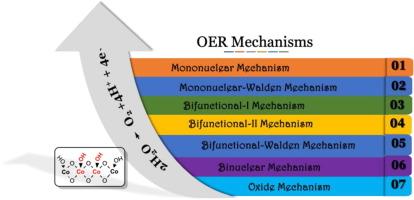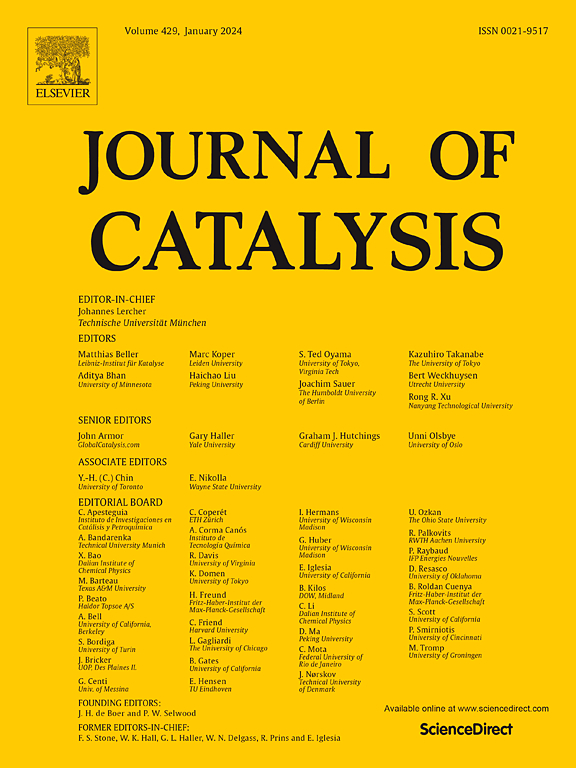Degree of span control to determine the impact of different mechanisms and limiting steps: Oxygen evolution reaction over Co3O4(001) as a case study
IF 6.5
1区 化学
Q2 CHEMISTRY, PHYSICAL
引用次数: 0
Abstract
Oxygen evolution reaction (OER) is the limiting process in electrolyzers for the production of green hydrogen. Although computational studies using density functional theory calculations provide insights into reaction mechanisms and limiting steps of OER catalysts, our mechanistic understanding is still limited even for state-of-the-art OER catalysts. This finding can be related to the fact that most computational studies rely on the approximation of the electrocatalytic activity by a single reaction mechanism and the limiting reaction step is solved by thermodynamic considerations, thereby assuming that the reaction rate is determined by a single step only. In this article, we present a framework to account for the mechanistic diversity in the formation of gaseous oxygen, using the example of a Co3O4 model catalyst due to the use of cobalt oxide-based materials in alkaline electrolysis. In addition to traditional reaction mechanisms, we consider Walden-like pathways in the analysis and show that multiple reaction mechanisms compete under OER conditions. To gain unprecedented insight into the limiting reaction steps, we introduce the concept of degree of span control, a thermodynamic representation based on Campbell’s generalized degree of rate control from thermal catalysis but aimed at the study of electrocatalytic processes. We demonstrate that in the OER over Co3O4(001), different reaction steps contribute to the OER current density to a different extent when the applied electrode potential is modulated. The degree of span control framework is considered useful for screening reaction mechanisms and limiting steps of catalytic processes at electrified solid–liquid interfaces before performing kinetic studies of selected elementary steps.

确定不同机制和限制步骤对跨度控制程度的影响:以Co3O4(001)上的析氧反应为例研究
析氧反应(OER)是电解槽生产绿色氢的限制过程。尽管使用密度泛函理论计算的计算研究提供了对OER催化剂的反应机理和限制步骤的见解,但我们对最先进的OER催化剂的机理理解仍然有限。这一发现可能与这样一个事实有关,即大多数计算研究依赖于单一反应机理对电催化活性的近似,而极限反应步骤是通过热力学考虑来解决的,从而假设反应速率仅由单一步骤决定。在本文中,我们提出了一个框架来解释气态氧形成的机制多样性,使用Co3O4模型催化剂的例子,由于在碱性电解中使用钴基材料。除了传统的反应机制外,我们在分析中还考虑了瓦尔登样途径,并表明在OER条件下多种反应机制相互竞争。为了获得对极限反应步骤的前所未有的深入了解,我们引入了跨度控制度的概念,这是一种基于坎贝尔热催化广义速率控制度的热力学表示,旨在研究电催化过程。我们证明了在Co3O4(001)上的OER中,当施加的电极电位被调制时,不同的反应步骤对OER电流密度的贡献程度不同。跨度控制框架的程度被认为是有用的筛选反应机理和限制步骤在电固液界面催化过程进行选定的基本步骤的动力学研究之前。
本文章由计算机程序翻译,如有差异,请以英文原文为准。
求助全文
约1分钟内获得全文
求助全文
来源期刊

Journal of Catalysis
工程技术-工程:化工
CiteScore
12.30
自引率
5.50%
发文量
447
审稿时长
31 days
期刊介绍:
The Journal of Catalysis publishes scholarly articles on both heterogeneous and homogeneous catalysis, covering a wide range of chemical transformations. These include various types of catalysis, such as those mediated by photons, plasmons, and electrons. The focus of the studies is to understand the relationship between catalytic function and the underlying chemical properties of surfaces and metal complexes.
The articles in the journal offer innovative concepts and explore the synthesis and kinetics of inorganic solids and homogeneous complexes. Furthermore, they discuss spectroscopic techniques for characterizing catalysts, investigate the interaction of probes and reacting species with catalysts, and employ theoretical methods.
The research presented in the journal should have direct relevance to the field of catalytic processes, addressing either fundamental aspects or applications of catalysis.
 求助内容:
求助内容: 应助结果提醒方式:
应助结果提醒方式:


